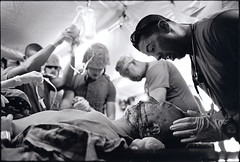As we ponder the tragedy for so many that is the meltdown of the sub-prime lending market, let us ponder
.
Well, seems like some of our poorest fellow citizens took Greenspan's sage advice, which would have been brilliant had he suggested it at the start of, say, the Clinton administration, but which looked...um...insane in 2004, when it was clear to many that the housing bubble was about to burst and interest rates poised to rise. And now, because our financial watchdogs decided to go with Greenspan and ignore the potential for a shake down in "exotic" mortgage and refinancing offerings, we're faced with
.
Here in Ohio, there are more than 200 vacant houses in Euclid, a suburb of Cleveland north of here. In the last two years more than 600 houses in Euclid have gone through foreclosure or started the process, many of them the homes of elderly people who refinanced with low two-year teaser rates, then saw their payments grow by 50 percent or more.
Euclid has installed alarm systems in some vacant houses to keep out people hoping to steal lights and other fixtures, drug users and squatters. The city has hired three new building inspectors, bringing the total to nine, to deal with troubled properties and is getting a $1 million loan from the county to cover the costs of rehabilitation, demolition and lawn care at the foreclosed houses. (When the properties are sold, such direct maintenance costs will be recovered through tax assessments.)
The Euclid mayor, Bill Cervenik, said the city, with a population of 53,000, was losing $750,000 a year in property taxes from the empty houses.
At greatest risk in Cleveland’s suburbs are the low- and moderate-income neighborhoods where subprime lending has soared. The practice involves lenders issuing mortgages at high interest rates for people with lower incomes or poor credit ratings, usually involving adjustable rates and sometimes no down payment and no investigation of the borrower’s circumstances.
“What makes the subprime mortgages so devastating from a community perspective is that they’re so concentrated geographically,” said Dan Immergluck, a professor of city planning at the Georgia Institute of Technology.
Rosa Hutchinson Yates, 62, had kept up payments on her tidy two-story house on Chagrin Boulevard in Shaker Heights for 30 years. Now, she may well lose the house because of a disastrous refinancing deal in 2003 that brought her $24,000 in cash but bills she could not pay.
Ms. Yates, who has worked as a beautician and a cocktail waitress, was emotional and confused as she tried to explain what happened. Though she signed the closing documents, she said she did not realize that she was getting an adjustable rate mortgage that did not include taxes and insurance.
In 2006, broke and bewildered, she stopped making payments and the lender started foreclosure proceedings. A Shaker Heights city attorney said it appeared that illegally high fees might have been charged and that the broker had overstated Ms. Yates’s income, raising the possibility of a legal challenge.
Ms. Yates, preparing for the worst, has learned that she can move into a subsidized apartment for retirees. But the thought is devastating.
“When folks pay for a home, they expect to die in it,” she said, breaking into tears.
In a report for Shaker Heights, Mark Duda and William C. Apgar of Harvard University found that expensive refinancing deals had been aggressively “push-marketed” in the city’s less affluent west and south sides, bordering Cleveland. They said that “the rising number of foreclosures threatens to undermine the stability” of those areas.
“The moral outrage,” Ms. Rawson, the mayor, said, “is that subprime lenders have targeted our seniors and African-Americans, people who saved all their lives to get a step up.”


